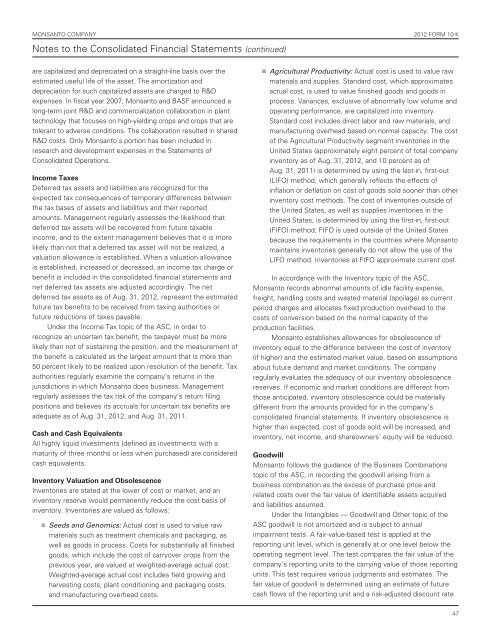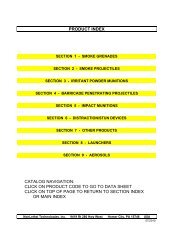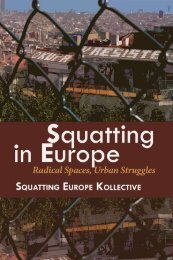monsanto-2012-annual-report
monsanto-2012-annual-report
monsanto-2012-annual-report
Create successful ePaper yourself
Turn your PDF publications into a flip-book with our unique Google optimized e-Paper software.
MONSANTO COMPANY <strong>2012</strong> FORM 10-K<br />
Notes to the Consolidated Financial Statements (continued)<br />
are capitalized and depreciated on a straight-line basis over the<br />
estimated useful life of the asset. The amortization and<br />
depreciation for such capitalized assets are charged to R&D<br />
expenses. In fiscal year 2007, Monsanto and BASF announced a<br />
long-term joint R&D and commercialization collaboration in plant<br />
technology that focuses on high-yielding crops and crops that are<br />
tolerant to adverse conditions. The collaboration resulted in shared<br />
R&D costs. Only Monsanto’s portion has been included in<br />
research and development expenses in the Statements of<br />
Consolidated Operations.<br />
Income Taxes<br />
Deferred tax assets and liabilities are recognized for the<br />
expected tax consequences of temporary differences between<br />
the tax bases of assets and liabilities and their <strong>report</strong>ed<br />
amounts. Management regularly assesses the likelihood that<br />
deferred tax assets will be recovered from future taxable<br />
income, and to the extent management believes that it is more<br />
likely than not that a deferred tax asset will not be realized, a<br />
valuation allowance is established. When a valuation allowance<br />
is established, increased or decreased, an income tax charge or<br />
benefit is included in the consolidated financial statements and<br />
net deferred tax assets are adjusted accordingly. The net<br />
deferred tax assets as of Aug. 31, <strong>2012</strong>, represent the estimated<br />
future tax benefits to be received from taxing authorities or<br />
future reductions of taxes payable.<br />
Under the Income Tax topic of the ASC, in order to<br />
recognize an uncertain tax benefit, the taxpayer must be more<br />
likely than not of sustaining the position, and the measurement of<br />
the benefit is calculated as the largest amount that is more than<br />
50 percent likely to be realized upon resolution of the benefit. Tax<br />
authorities regularly examine the company’s returns in the<br />
jurisdictions in which Monsanto does business. Management<br />
regularly assesses the tax risk of the company’s return filing<br />
positions and believes its accruals for uncertain tax benefits are<br />
adequate as of Aug. 31, <strong>2012</strong>, and Aug. 31, 2011.<br />
Cash and Cash Equivalents<br />
All highly liquid investments (defined as investments with a<br />
maturity of three months or less when purchased) are considered<br />
cash equivalents.<br />
Inventory Valuation and Obsolescence<br />
Inventories are stated at the lower of cost or market, and an<br />
inventory reserve would permanently reduce the cost basis of<br />
inventory. Inventories are valued as follows:<br />
Seeds and Genomics: Actual cost is used to value raw<br />
materials such as treatment chemicals and packaging, as<br />
well as goods in process. Costs for substantially all finished<br />
goods, which include the cost of carryover crops from the<br />
previous year, are valued at weighted-average actual cost.<br />
Weighted-average actual cost includes field growing and<br />
harvesting costs, plant conditioning and packaging costs,<br />
and manufacturing overhead costs.<br />
Agricultural Productivity: Actual cost is used to value raw<br />
materials and supplies. Standard cost, which approximates<br />
actual cost, is used to value finished goods and goods in<br />
process. Variances, exclusive of abnormally low volume and<br />
operating performance, are capitalized into inventory.<br />
Standard cost includes direct labor and raw materials, and<br />
manufacturing overhead based on normal capacity. The cost<br />
of the Agricultural Productivity segment inventories in the<br />
United States (approximately eight percent of total company<br />
inventory as of Aug. 31, <strong>2012</strong>, and 10 percent as of<br />
Aug. 31, 2011) is determined by using the last-in, first-out<br />
(LIFO) method, which generally reflects the effects of<br />
inflation or deflation on cost of goods sold sooner than other<br />
inventory cost methods. The cost of inventories outside of<br />
the United States, as well as supplies inventories in the<br />
United States, is determined by using the first-in, first-out<br />
(FIFO) method; FIFO is used outside of the United States<br />
because the requirements in the countries where Monsanto<br />
maintains inventories generally do not allow the use of the<br />
LIFO method. Inventories at FIFO approximate current cost.<br />
In accordance with the Inventory topic of the ASC,<br />
Monsanto records abnormal amounts of idle facility expense,<br />
freight, handling costs and wasted material (spoilage) as current<br />
period charges and allocates fixed production overhead to the<br />
costs of conversion based on the normal capacity of the<br />
production facilities.<br />
Monsanto establishes allowances for obsolescence of<br />
inventory equal to the difference between the cost of inventory<br />
(if higher) and the estimated market value, based on assumptions<br />
about future demand and market conditions. The company<br />
regularly evaluates the adequacy of our inventory obsolescence<br />
reserves. If economic and market conditions are different from<br />
those anticipated, inventory obsolescence could be materially<br />
different from the amounts provided for in the company’s<br />
consolidated financial statements. If inventory obsolescence is<br />
higher than expected, cost of goods sold will be increased, and<br />
inventory, net income, and shareowners’ equity will be reduced.<br />
Goodwill<br />
Monsanto follows the guidance of the Business Combinations<br />
topic of the ASC, in recording the goodwill arising from a<br />
business combination as the excess of purchase price and<br />
related costs over the fair value of identifiable assets acquired<br />
and liabilities assumed.<br />
Under the Intangibles — Goodwill and Other topic of the<br />
ASC goodwill is not amortized and is subject to <strong>annual</strong><br />
impairment tests. A fair-value-based test is applied at the<br />
<strong>report</strong>ing unit level, which is generally at or one level below the<br />
operating segment level. The test compares the fair value of the<br />
company’s <strong>report</strong>ing units to the carrying value of those <strong>report</strong>ing<br />
units. This test requires various judgments and estimates. The<br />
fair value of goodwill is determined using an estimate of future<br />
cash flows of the <strong>report</strong>ing unit and a risk-adjusted discount rate<br />
47





